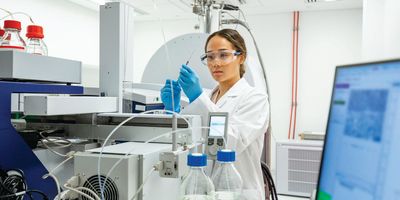LC-MS: A Powerful Tool in Unravelling the Mysteries of PFAS
Utilizing precise analytical techniques may offer a potential solution to this persistent problem
Often termed, “forever chemicals”, per- and polyfluoroalkyl substances (PFAS) are a ubiquitous group of chemicals that are posing a “forever problem” due to their persistence in the environment. Despite the known risks associated with these chemicals, they are still widely used in many consumer products, including food packaging, personal care products, and household items. These chemicals have been found to have harmful effects on human health, flora, fauna, and the ecosystem at large. Aleksandra Peliushkevich, PhD, an MSc science communication student at the UWE Bristol with a PhD in pharmaceutical science, mentions that “It is so important to determine the concentration of PFAS accurately and reliably as it would provide a better understanding of the problem (PFAS) as well as an opportunity to discuss it more openly and transparently.”
Analyzing PFAS with LC-MS
The most common method for testing PFAS is liquid chromatography-mass spectrometry (LC-MS). Samples containing PFAS, obtained from environmental matrices (water, soil, sediments) or biological tissues, undergo sample preparation, often through solid-phase extraction (SPE), and then are injected into the LC system to separate individual PFAS compounds based on their chemical properties. This separation is achieved via a chromatographic column with a specific stationary phase, chosen based on the targeted PFAS compounds and the intended separation. Within the LC, PFAS compounds interact with the stationary phase (column) and the mobile phase (solvent). The preference of a compound for the stationary or mobile phase determines its retention time, with longer-chain PFAS compounds exhibiting different retention times than shorter-chain ones.
Typically, the longer a compound is retained in the column, the less polar it is, facilitating the separation of PFAS compounds. The LC system then generates a chromatogram, where each PFAS compound appears as a distinct peak with an individual retention time.
Besides LC-MS, other analytical techniques suitable for detecting PFAS include tandem mass spectrometry (MS-MS) and multiple reaction monitoring (MRM). These techniques are used to improve the accuracy of an analysis.
After LC separates the compounds, the MS primarily detects PFAS compounds based on their molecular weight. The eluent from the LC system, containing separated PFAS compounds, then enters the MS system and undergoes ionization. Common ionization techniques, such as electrospray ionization or atmospheric pressure chemical ionization, ionize the PFAS molecules. Ionized PFAS molecules then enter the mass analyzer, where they are separated based on their mass-to-charge ratio (m/z). MS generates data consisting of mass spectra and retention times. These are recorded in a total ion chromatogram, where peaks correspond to individual PFAS compounds. To accurately quantify PFAS compounds, specialized software analyzes the data. This analysis requires calibration standards with known concentrations to ensure accurate quantification. Quality control measures such as method blanks and internal standards are used to monitor and correct possible interferences and variability. These measures help ensure that accurate results are obtained.
LC-MS expert and trainer, associate professor ChM Fatimah Salim, PhD, from the Malaysian Institute of Chemistry Professional Centre and research fellow at the Atta-ur-Rahman Institute for Natural Product Discovery, Universiti Teknologi MARA, Malaysia, mentions, “By combining the separation capabilities of the LC with the sensitivity and specificity of the MS, the LC-MS technique provides a powerful analytical tool for detailed information on the composition and concentration of PFAS in intricate sample matrices. The ability to selectively analyze individual PFAS compounds is crucial in assessing environmental contamination and understanding potential health risks associated with these substances.”
Other methods for analyzing PFAS
Besides LC-MS, other analytical techniques suitable for detecting PFAS include tandem mass spectrometry (MS-MS) and multiple reaction monitoring (MRM). These techniques are used to improve the accuracy of an analysis. In MS-MS mode, precursor ions are fragmented into smaller product ions, which are then detected. According to Salim, “Tandem MS enhances specificity and sensitivity by selecting precursor ions, fragmenting them, and monitoring specific mass transitions. This sophisticated approach enables precise identification and quantification of PFAS compounds based on their distinctive mass spectra. On the other hand, MRM monitors specific mass transitions for each PFAS compound, which enhances the selectivity and sensitivity of the analysis.”
LC is often paired with MS-MS for another widely used and trustworthy analytical technique (LC-MS-MS) for detecting and measuring PFAS compounds. This method is incredibly precise, very sensitive, and requires a relatively simple sample preparation (solid-phase extraction). However, it is only capable of identifying well-known “legacy” compounds, and analyzing the data can be a very labor-intensive process.
Improving the process
Chromatography and other analytical techniques have some drawbacks, as they require very complex instruments with lengthy diagnostic processes. According to Generalova Yuliya, PhD, a researcher at the Center for Quality Control of Medicines, Saint-Petersburg State Chemical and Pharmaceutical University, Russia, some emerging new techniques that may complement LC-MS for PFAS identification are the use of sensor technologies, total oxidizable precursor (TOP) assays, fluorine-19 nuclear magnetic resonance spectroscopy, and inductively coupled plasma mass spectrometry. Yuliya mentions, “Recent advancements in sensor technologies have led to the development of smaller and more portable LC-MS systems. These systems enable on-site analysis, making it quicker and easier to detect PFAS in a variety of environments, such as water treatment plants and contaminated sites.” TOP assays, on the other hand, provide a comprehensive assessment of PFAS that allows a thorough understanding of the extent of PFAS contamination in a sample. This information is crucial in risk assessment to predict their persistence in the environment and to subsequently develop the necessary remediation strategies.

